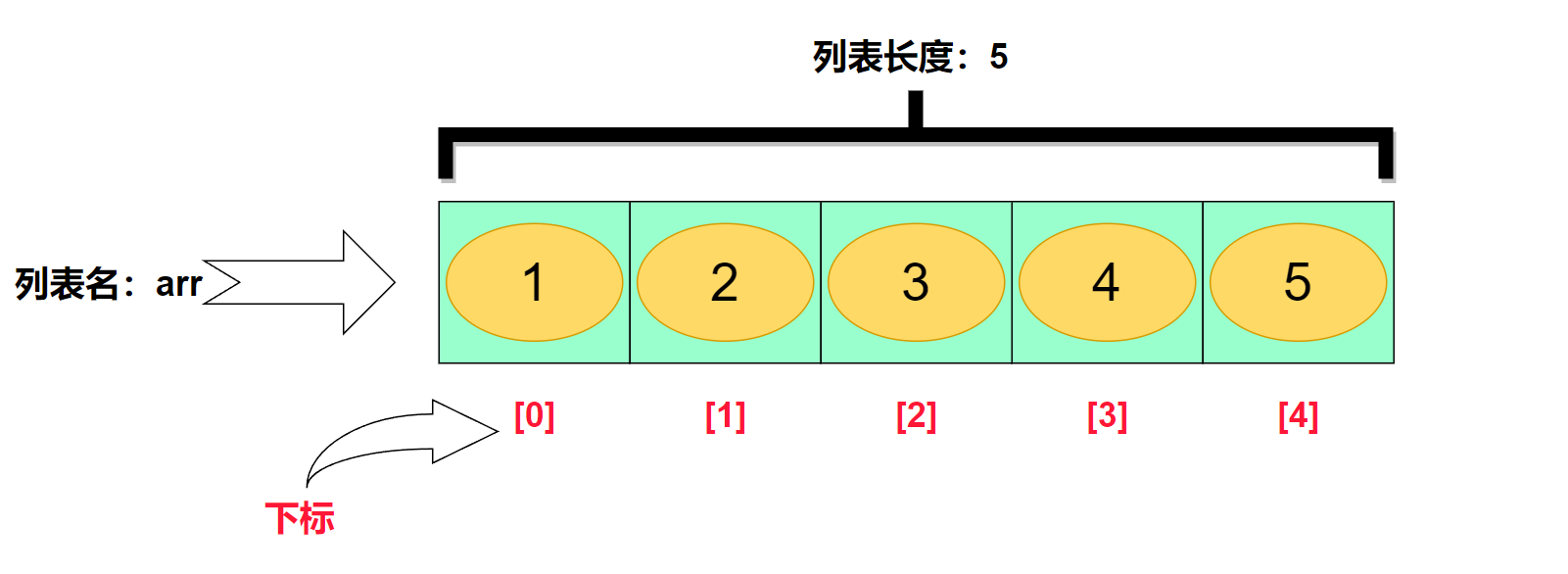Python05 数据序列-列表
创始人
2025-05-30 11:21:07
Python05 数据序列-列表
5.1 列表概述
python列表是一种有序且可变的序列,列表使用中括号[]进行定义,各项元素之间使用逗号分隔。python的列表与其他编程语言中的数组很像,但独特之处在于python可以存储任意类型的数据。
使用场景:
需要存放1000个学生的学号,安装之前的方式,我们需要定义1000个变量存储,非常麻烦,那么我们可以使用数组进行存储。
5.2 列表的定义与使用
格式:
列表名 = [数据1,数据2,数据3......]
- 使用中括号[]进行定义,各项元素之间使用英文逗号分隔。
- 列表可以一次性存储多个数据,且可以为不同数据类型。
使用:直接通过 变量名 进行 使用
案例:
ids = [1, 2, 3, 4, 5]
print(ids) # [1, 2, 3, 4, 5]
print(ids[2]) # 3
图解:

5.3 列表的常用操作
列表的常见操作:增、删、改、查
表1 列表的常见操作
| 常见操作 | 说明 |
|---|---|
| len(s) | 计算序列s的长度(元素个数) |
| min(s) | 返回序列s中的最小元素 |
| max(s) | 返回序列s中的最大元素 |
| list.append() | 在列表list的末尾添加元素x |
| list.extend() | 在列表list中添加列表lx的元素,与+=功能相同 |
| list.insert() | 在列表list索引为i的元素之前插入元素x |
| listpop() | 取出并删除列表list中索引为i的元素x |
| List.remove() | 删除列表list中第一次出现的元素x |
| list.reverse() | 将列表list的元素反转 |
| list.clear() | 删除列表list中的所有元素 |
| list.copy() | 生成新列表,并拷贝列表list中的所有元素 |
| list.sort() | 将列表list中的元素排序 |
5.3.1 查找
5.3.1.1 下标查找
ids = [1, 2, 3, 4, 5]
print(ids) # [1, 2, 3, 4, 5]
print(ids[2]) # 3
print(ids[0]) # 1
print(ids[1]) # 2
5.3.1.2 函数查找
- index():查找指定数据所在位置下标
格式:
列表.index(数据,开始位置,结束位置)
如果存在多个数据,那么返回是相匹配的第一个数据下标
idnex(数据):如果不知道位置,默认整个列表中查找
案例:
ids = [1, 2, 3, 4, 5]
print(ids.index(4)) # 3
print(ids.index(4, 1, 5)) # 3
print(ids.index(4, 4, 5)) # ValueError: 4 is not in list
print(ids.index(49)) # ValueError: 49 is not in list
注意:如果查找的数据不存在则报错。
- count():统计指定数据在列表中出现的次数
格式:
列表.count(数据)
案例:
ids = [1, 2, 3, 4, 5]
print(ids.count(4)) # 1
print(ids.count(9)) # 0
注意:如果数据不存在也不会报错
- len():获取列表的长度(列表中数据的个数)
格式:
len(列表)
案例:
ids = [1, 2, 3, 4, 5]
print(len(ids) ) # 5
5.3.1.3 判断查找
- in : 判断数据是否列表序列中,如果在返回True,否则返回False
格式:
数据 in 列表
案例:
ids = [1, 2, 3, 4, 5]
print(1 in ids ) # True
print(123 in ids ) # False
- not in : 判断数据是否列表序列中,如果在返回False,否则返回True
格式:
数据 not in 列表
案例:
ids = [1, 2, 3, 4, 5]
print(1 not in ids ) # False
print(123 not in ids ) # True
5.3.2 增加
增加指定的数据到列表中
- append():在列表的结尾追加数据
格式:
列表.append(数据)
案例:
ids = [1, 2, 3, 4, 5]
ids.append(89)
print(ids) # [1, 2, 3, 4, 5, 89]
注意:
如果append()追加的数据是一个序列,则追加整个序列到列表
ids = [1, 2, 3, 4, 5]
nams=["张三","李四"]
ids.append(nams)
print(ids) # [1, 2, 3, 4, 5, ['张三', '李四']]
- extend():列表结尾追加数据,如果数据是一个序列,则将这个序列的数据逐一添加到列表。
格式:
列表.extend(数据)
案例:
ids = [1, 2, 3, 4, 5]
ids.extend("4")
ids.extend("9")
nams = ["张三", "李四"]
ids.extend(nams)
print(ids) # [1, 2, 3, 4, 5, '4', '9', '张三', '李四']
- insert():在指定位置插入数据。
格式:
列表.insert(位置下标,数据)
案例:
ids = [1, 2, 3, 4, 5]
ids.insert(3, "in")
print(ids) # [1, 2, 3, 'in', 4, 5]
5.3.3 删除
- del : 删除列表 | 指定下标数据
格式:
del 列表 | 列表[下标]
案例:
# 删除指定数据
ids = [1, 2, 3, 4, 5]
del ids[2]
print(ids) # [1, 2, 4, 5]
# 删除整个列表
del ids
print(ids) # NameError: name 'ids' is not defined
del 删除时不指定下标,会删除整个列表,并释放内存空间
- pop():删除指定下标的数据(默认为最后一个),并返回该数据。
格式:
列表.pop(下标)
案例:
ids = [1, 2, 3, 4, 5]
# 删除指定下标数据
print(ids.pop(2)) # 3
print(ids) # [1, 2, 4, 5]
# 不指定下标,默认删除最后一个
print(ids.pop()) # 5
print(ids)
- remove():删除列表中指定数据的第一个匹配项。
格式:
列表.remove(数据)
案例:
ids = [1, 2, 3, 4, 5]
ids.remove(1)
ids.remove(10)# ValueError: list.remove(x): x not in list
print(ids)
如果删除的数据不存在,就会报错
ValueError: list.remove(x): x not in list
- clear():清空列表
格式:
列表.clear()
案例:
ids = [1, 2, 3, 4, 5]
ids.clear()
print(ids) # []
5.3.4 修改
- 通过下标修改
格式:
列表[下标] = 数据
案例:
ids = [1, 2, 3, 4, 5]
ids[0] = 99
print(ids) # [99, 2, 3, 4, 5]
- reverse():倒叙反转
格式:
列表.reverse()
案例:
ids = [1, 2, 3, 4, 5]
ids.reverse()
print(ids) # [5, 4, 3, 2, 1]
- sort():排序
格式:
列表.sort(key=None,reverse=True | False )
reverse=True : 倒序(降序) ,reverse=False:正序(升序,默认)
案例:
ids = [6, 0, 1, 99, 3, 4, 5]
ids.sort()
print(ids) # [0, 1, 3, 4, 5, 6, 99]
ids.sort(reverse=True)
print(ids) # [99, 6, 5, 4, 3, 1, 0]
ids.sort(reverse=False)
print(ids) # [0, 1, 3, 4, 5, 6, 99]
5.3.5 复制
- copy():复制
格式:
列表.copy()
案例:
ids = [1, 2, 3, 4, 5]
new_ids = ids.copy()
print(new_ids) # [1, 2, 3, 4, 5]
5.4 列表遍历
去获取或者打印列表中的每一个数据
- for 遍历
案例:
ids = [1, 2, 3, 4, 5]
for i in ids:print(i)
- while 遍历
ids = [1, 2, 3, 4, 5]
i = 0 # i:下标
while i <= len(ids) - 1:print(ids[i])i += 1
5.5 列表嵌套(多维列表)
列表嵌套相当于其他语言中的多维数据
比如:定义一个年级,年级中有三个班级
案例:
# nj21 = [["张三", "李四", "王二"],["小明", "迪迦"],["彦祖", "冠希", "你"]]
nj21 = []
bj01 = ["张三", "李四", "王二"]
bj02 = ["小明", "迪迦"]
bj03 = ["彦祖", "冠希", "你"]
# 将 班级 放入 年级中
nj21.append(bj01)
nj21.append(bj02)
nj21.append(bj03)
# print(nj21)
# 有一天,有一个塞亚他要插班,要将座位放在迪迦的前面
flag = False # 定义标志,表示插班成功
for bj in nj21: # 遍历年级for bj_stu in bj:if bj_stu == "迪迦":dj_index = bj.index(bj_stu)print("迪迦的下标:", dj_index)bj.insert(dj_index, "塞亚")print("塞亚插班成功!正在退出循环")# 插班成功,将标志改成 Trueflag = Truebreak # 停止的 内层循环,思考?当插入之后停止所有!print(bj)# 判断标志,是否插班成功,如果成功,就退出if flag == True:print("退出成功!")break
print("插入的年级信息:", nj21)
5.6 练习
好友信息管理(姓名,性别,联系)
功能:查看所有好友信息修改指定好友信息删除指定好友增加好友清空好友列表退出
user = "root"
pwd = "root"
friends = [["张三", "男", 135897],["李四", "男", 135897],["李四", "男"]
] # 存储好友while True:in_user = input("请输入用户名:")in_pwd = input("请输入密码:")# 比较用户名和密码是否一致if user == in_user and pwd == in_pwd:while True:# 登录成功,显示功能面板print(10 * "=" + "欢迎使用好友管理系统" + 10 * "=")print("""1:查看所有好友信息2:增加好友3:删除指定好友4:修改指定好友信息5:清空好友列表0:退出系统""")# 让用户选择想要进行的功能x = input("请输入想要进行的操作:")if x == "1":# 查看所有好友信息# 判断好友列表是否存在信息if len(friends) == 0:print("你现在并没有好朋友!请选择其他操作!")else:# 存在好友print("姓名\t\t性别\t\t电话")for i in friends:for j in i:print(j, end="\t\t")print()elif x == "2":# 增加好友name = input("请输入姓名:")sex = input("请输入性别:")tel = input("请输入电话号码:")list = [name, sex, tel]# 判断 list 信息是否已经在 friends列表中存在if list not in friends:friends.append(list)print(f"{name} 信息增加成功!")else:print("好友已经存在,不需要重复增加!")elif x == "3":# 删除指定好友del_name = input("请输入需要删除的好友姓名:")del_flag = False # 定义标志,表示删除好友成功for friend in friends:if del_name in friend:friends.remove(friend) # friends.remove(["张三", "男", 135897])print(f"好友:{del_name} 信息删除成功!")del_flag = Truebreak# 判断 del_flag 是否为 True,为 Fasle 表示好友不存在,没有删除if del_flag == False:print(f"删除失败!好友:{del_name} 不存在!")elif x == "4":# 修改指定好友信息up_name = input("请输入需要修改信息的好友姓名:")up_flag = False # 定义标志,表示好友不存在,提示信息for friend in friends:if up_name in friend: # friend=["张三", "男", 135897]# 开始修改new_name = input("新的姓名:")new_sex = input("新的性别:")new_tel = input("新的电话:")# 先找到 friend 在 friends列表中的下标index = friends.index(friend)friends[index] = [new_name, new_sex, new_tel]print("信息修改成功!")# 修改成功之后,将up_flag 改为 True ,修改成功up_flag = Truebreak# 判断 up_flag ,用于判断修改是否成功if up_flag == False:print(f"修改失败!好友:{up_name} 不存在!")elif x == "5":# 清空好友列表while True:sure = input("您确定需要清空所有好友吗?(y/n)")if sure == "y":friends.clear()print("好友列表清空成功!")breakelif sure == "n":print("ok!不清空好友列表!")breakelse:print("您的输入有误!请重新输入!")elif x == "0":print("欢迎下次使用!彦祖")exit(0)else:print("您输入有误!")else:print("用户名或密码错误!请重新输入!")
相关内容
热门资讯
双子座流星雨划过各地夜空
12月13日至14日,年度“终极浪漫天象”,一年一度的双子座流星雨来临。双子座流星雨是北半球三大流星...
三案合并查处罚没6528万 永...
中经记者 孙汝祥 夏欣 北京报道12月13日,江苏证监局公布对永拓会计师事务所(以下简称“永拓所”)...
约车“张冠李戴” 司机收入缩水...
据央视新闻消息,数据显示,2024年我国网络货运市场规模已突破930亿元,发展势头迅猛。然而,快速增...
四年来总结
我们来总结一下这四年以来行情的变化。前三年有3000点之下有很好的机会,只不过这个时候大多数人倾向于...
